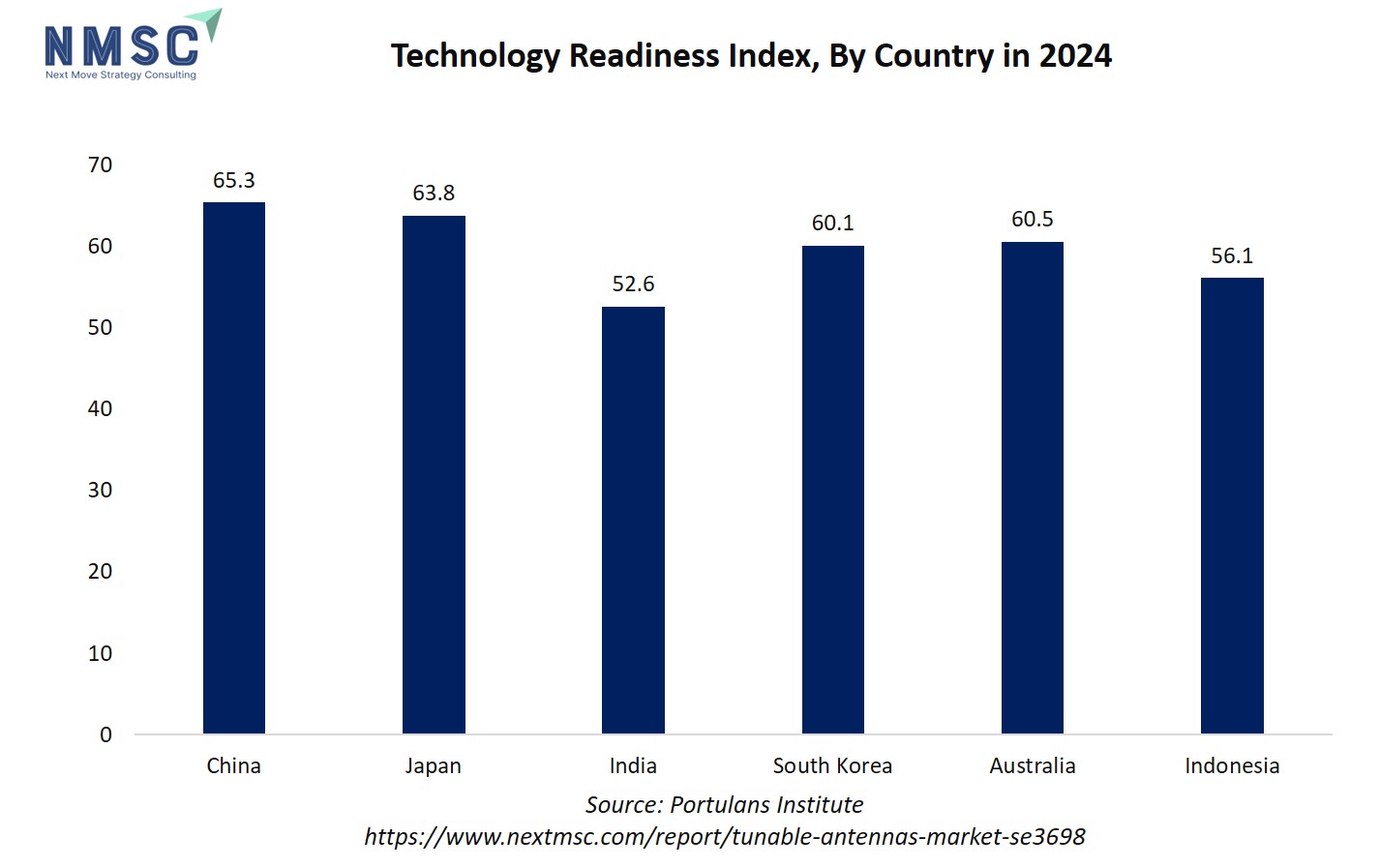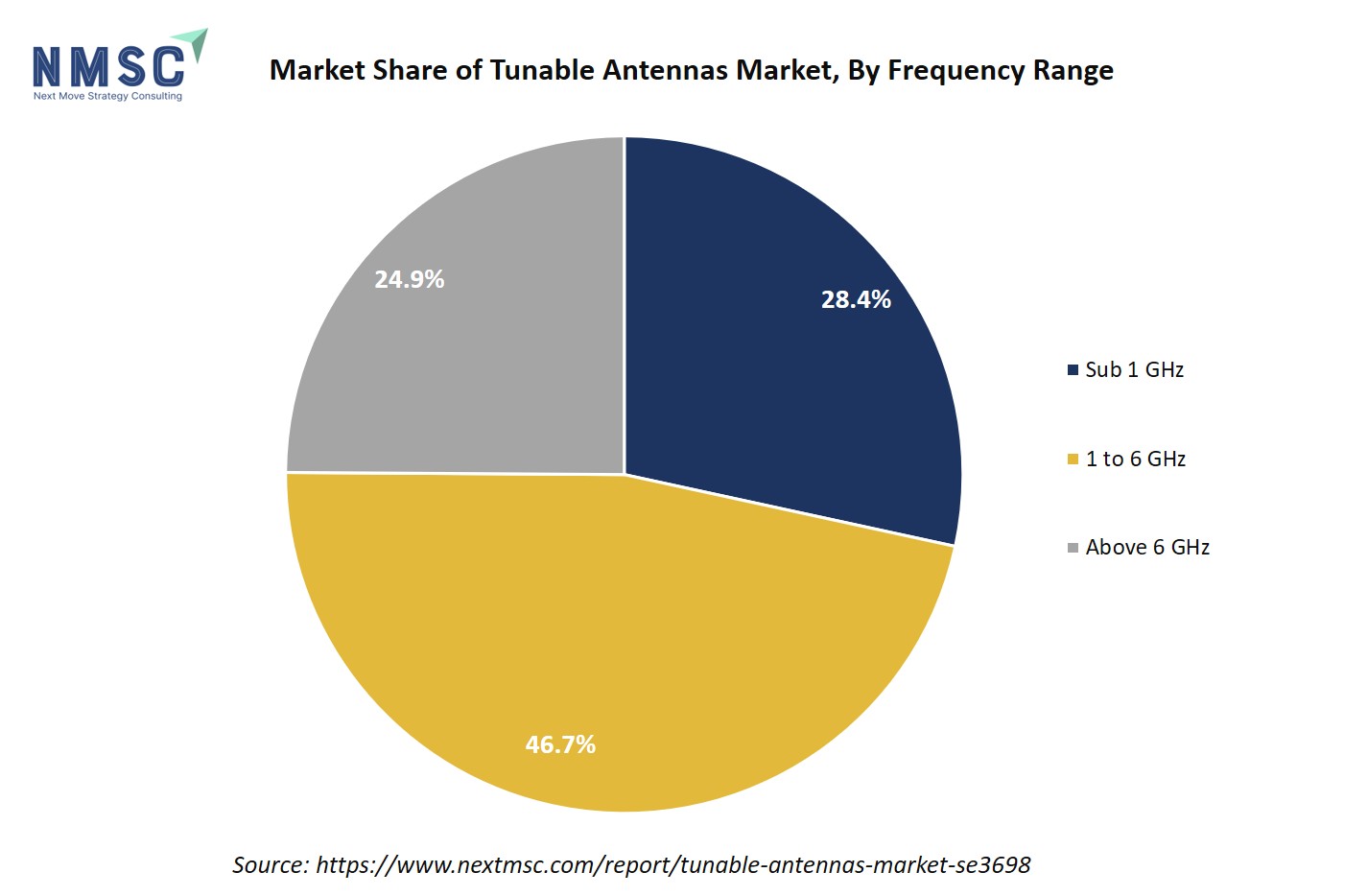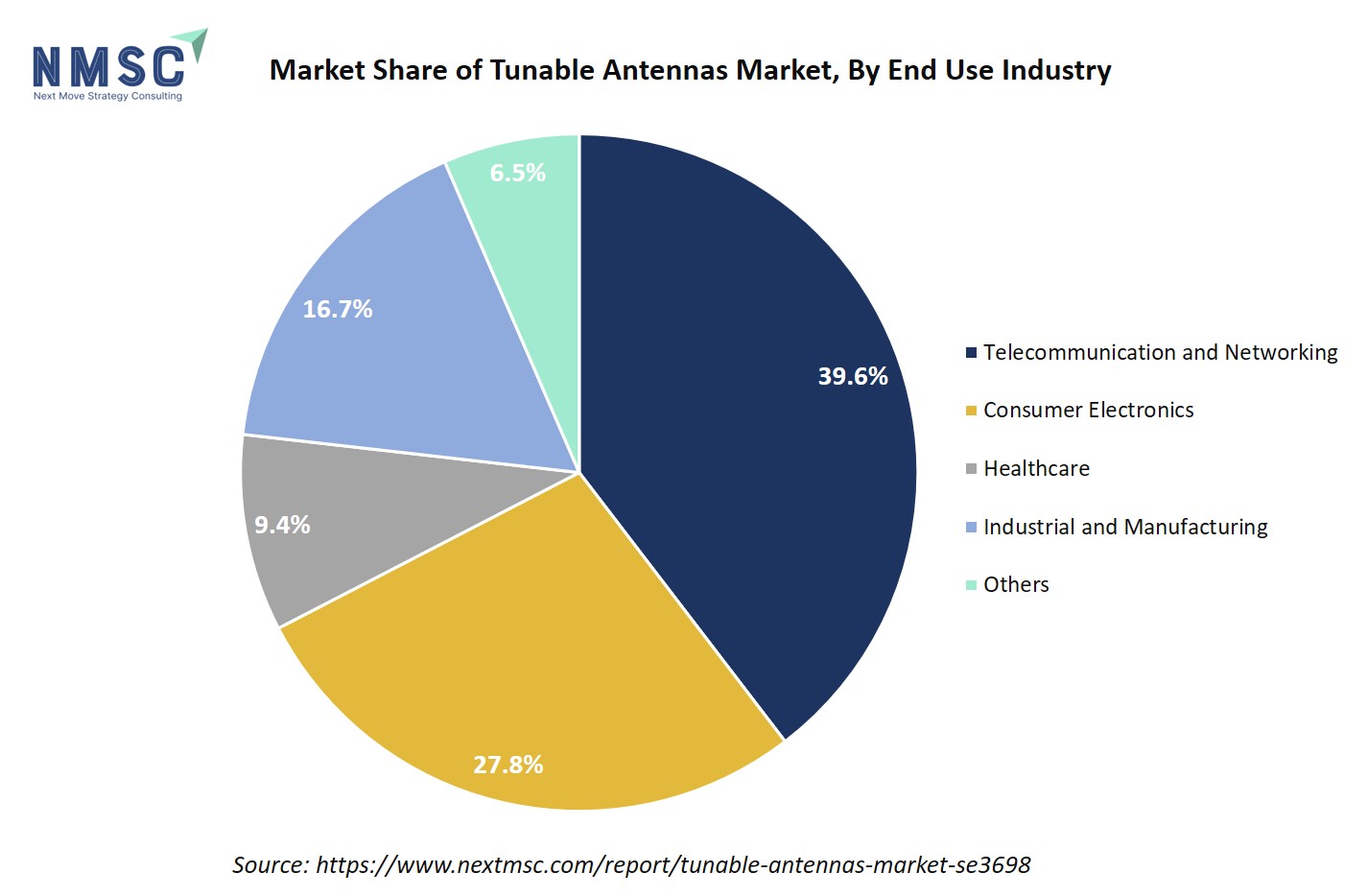
Tunable Antennas Market by Product Type (Frequency Tunable Antennas, Radiation Pattern Tunable Antennas, and Others), by Tuning Technology (MEMS-Based Tunable Antennas, Varactor Diode-Based Tunable Antennas and Others), by Frequency Range (Sub 1 GHz, 1 to 6 GHz, above 6 GHz), by Application (Smartphones and Consumer Devices, Wireless Communication Infrastructure and Others), and by End Use Industry (Telecommunication and Networking, Healthcare, and Others) – Global Analysis & Forecast, 2025–2030
Industry Outlook
The global Tunable Antennas Market size was valued at USD 1.47 billion in 2024, and is expected to be valued at USD 1.67 billion by the end of 2025. The industry is projected to grow, hitting USD 3.14 billion by 2030, with a CAGR of 13.5% between 2025 and 2030.
The sector is experiencing rapid growth, driven by increasing demand for adaptable and high-performance communication solutions. Tunable antennas are gaining traction across applications such as 5G networks, IoT devices, and defense systems due to their ability to improve signal quality, reduce interference, and enhance connectivity.
Technological advancements in semiconductor materials and antenna design are enabling more compact, efficient, and versatile products. The market growth is further supported by the proliferation of smart devices, rising need for reliable wireless communication, and the push for innovative antenna solutions in modern infrastructure, positioning adaptive antennas as a critical component in next-generation communication technologies.
What are the Key Tunable Antennas Market Trends?
What are the Major Technological Trends Shaping the Market?
The tunable antennas market demand is being shaped by several important trends. Technological advancements are driving innovation, with developments in materials, miniaturization, and adaptive design enhancing antenna performance, efficiency, and bandwidth. AI-driven tuning, automated calibration, and smart signal processing are improving connectivity, reducing interference, and enabling seamless integration into 5G, IoT, and defense applications.
Advanced manufacturing techniques, including precision fabrication and additive manufacturing, are increasing production efficiency and consistency. Furthermore, eco-friendly designs and lightweight, compact form factors are gaining attention, meeting both performance and sustainability requirements.
How is Demographic Change Influencing the Market?
Demographic and societal changes are also influencing the tunable antennas market dynamics. Rising deployment of smart devices, increasing urbanization, and the growing adoption of wireless technologies in both residential and industrial settings are boosting demand.
Emerging regions with expanding digital infrastructure, such as Asia-Pacific, are witnessing heightened adoption of smart antennas, while mature markets are seeking upgrades to 5G and next-generation networks. The increasing number of tech-savvy professionals, IoT-enabled homes, and connected industrial environments is driving the need for versatile, high-performance antennas.
What Role does Government Support Play in Driving Industry Growth?
Government support plays a key role in the tunable antennas market expansion. Initiatives promoting 5G rollout, research grants for advanced communication technologies, and spectrum allocation policies are encouraging investment and innovation in RF tunable components development. Policies supporting domestic manufacturing, export incentives, and standards for wireless equipment quality and safety are further enhancing industry growth and competitiveness.
How is Consumer Preference Changing in the Market?
Consumer and industry preferences are shifting toward high-performance, compact, and energy-efficient antenna solutions. There is growing demand for adaptive antennas capable of operating across multiple frequency bands with minimal power consumption. End-users prioritize reliability, low latency, and seamless integration with existing networks.
In addition, manufacturers focusing on sustainable materials, modular designs, and scalable solutions are gaining a competitive edge, reflecting a transition from traditional fixed antennas to advanced, tunable, and environmentally conscious technologies.
This chart highlights the 2024 Technology Readiness Index for selected Asia-Pacific countries, with China (65.3) and Japan (63.8) leading, followed by Australia (60.5), South Korea (60.1), Indonesia (56.1), and India (52.6), indicating their relative capacity to develop and adopt advanced communication technologies.
In the context of the tunable antennas market share, higher scores suggest that countries such as China and Japan are better positioned to drive innovation in adaptive antenna systems, support large-scale deployment of 5G and next-generation wireless networks, and integrate antenna tuning technologies across industrial and defense applications.
In contrast, the countries with lower scores face slower adoption due to limitations in infrastructure maturity, regulatory frameworks, and technical expertise required to support the widespread implementation of tunable antenna solutions.
What are the Key Market Drivers, Breakthroughs, and Investment Opportunities that will Shape the Tunable Antennas Industry in Next Decade?
The global tunable antennas market is witnessing robust growth, primarily driven by the rapid expansion of 5G networks and the rise of urbanization coupled with smart infrastructure development. 5G deployment demands antennas capable of multi-band operation, high-speed data transmission, and low-latency performance, positioning tunable antennas as a critical solution for applications such as autonomous vehicles, IoT devices, and smart cities.
Simultaneously, the surge in connected devices and IoT ecosystems is fueling demand for compact, versatile, and energy-efficient antennas. However, high manufacturing costs and complex production requirements pose challenges to widespread adoption. Despite these restraints, opportunities abound as manufacturers innovate to meet the evolving needs of consumer, commercial, and industrial applications.
Growth Drivers:
How is 5G Network Expansion Driving the Tunable Antennas Market Demand?
The rapid global rollout of 5G networks is a major driver of the tunable antennas market growth. 5G technology requires antennas capable of operating across multiple frequency bands, supporting high-speed data transmission, and maintaining low latency for applications such as autonomous vehicles, IoT devices, and smart infrastructure. Tunable antennas are particularly suited to meet these requirements due to their adaptability, ability to optimize signal quality in real time, and efficient spectrum usage.
As telecom operators invest heavily in expanding 5G coverage, there is growing demand for advanced antenna solutions that enhance network performance, increase reliability, and accommodate the increasing number of connected devices. This widespread adoption of 5G infrastructure is significantly boosting the deployment and development of tunable antennas worldwide.
Is Urbanization and Smart Infrastructure Accelerating the Market Growth?
Rapid urbanization and the development of smart infrastructure are driving demand for tunable antennas. As cities expand and modernize, there is increasing deployment of smart city solutions, including connected traffic systems, IoT-enabled public services, and high-speed wireless networks.
Tunable antennas play a critical role in these applications by providing flexible, reliable, and high-performance connectivity across diverse frequency bands. The growth of smart homes, industrial IoT, and intelligent transportation systems further boosts the need for versatile antenna solutions that adapt to varying signal requirements. This trend is encouraging manufacturers to innovate and supply antennas that support urban digital transformation, creating significant opportunities in both developed and emerging markets.
Growth Inhibitors:
How does High Manufacturing Costs Restraints the Growth of the Market?
The development and production of adaptive antennas involve advanced materials, precision fabrication, and sophisticated calibration technologies, which increase manufacturing costs. These high costs limit adoption, particularly among small- and medium-sized device manufacturers or in price-sensitive markets. Additionally, the need for specialized design and testing to ensure performance across multiple frequency bands further add to production expenses, potentially slowing market penetration in emerging regions.
How is Growing Demand in IoT and Connected Devices Creating Opportunity for the Market?
The rapid proliferation of IoT devices, smart homes, and industrial automation systems presents a significant opportunity for the market. As the number of connected devices continues to surge, there is increasing demand for compact, versatile, and high-performance antennas capable of supporting multiple frequency bands and minimizing interference. Manufacturers that develop scalable, energy-efficient, and adaptive tunable antennas capitalize on this growing ecosystem, expanding their market presence across consumer, commercial, and industrial applications.
How is the Tunable Antennas Market Report Segmented, and What are the Key Insights from the Segmentation Analysis?
By Product Type Insights
Which Species Type Is Expected to Drive the Tunable Antennas Market in 2025?
On the basis of product type, the market is segmented into frequency tunable antennas and others.
Frequency tunable antennas represent a key product segment within the tunable antennas market, designed to dynamically adjust their operating frequency to optimize signal performance across different communication bands. These antennas enable seamless switching between multiple frequency ranges without the need for multiple fixed antennas, making them highly valuable for applications in 5G networks, defense communication systems, aerospace platforms, and IoT devices. By providing enhanced flexibility, reduced hardware complexity, and improved spectrum efficiency, frequency tunable antennas play a vital role in meeting the growing demand for adaptive and reconfigurable wireless systems. Their ability to support diverse communication standards and minimize interference positions them as a crucial technology driving innovation and growth across the global market.
By Frequency Range Insights
Which Frequency Range is Expected to Drive the Tunable Antennas Market in 2025?
On the basis of frequency range, the market is segmented into sub 1 GHz, 1 to 6 GHz.
Sub 1 GHz Tunable Antennas form an important segment of the tunable antennas market, primarily catering to applications that require long-range communication, strong signal penetration, and reliable connectivity in challenging environments. Operating below 1 GHz, these antennas are widely used in IoT networks, smart metering, industrial monitoring, defense communication, and low-frequency wireless systems, where coverage and power efficiency are more critical than data speed. Their tunable nature allows them to dynamically adapt to different frequencies within the sub-GHz band, optimizing performance for various regional standards and environmental conditions. This segment plays a key role in enabling energy-efficient, wide-area, and low-power communication solutions, supporting the growing need for connected devices and resilient wireless infrastructure in the market.
This chart represents the market share distribution of the Tunable Antennas Market by Frequency Range, illustrating how demand is divided across different operating frequency bands. The 1 to 6 GHz segment holds the largest share, driven by its extensive use in 5G networks, wireless communication infrastructure, and IoT devices that require balanced coverage and high data capacity. The Sub 1 GHz segment accounts for a significant portion due to its suitability for long-range, low-power applications such as smart metering and industrial monitoring. Meanwhile, the Above 6 GHz segment represents emerging opportunities in advanced technologies like millimeter-wave communication, radar systems, and aerospace applications. Overall, the chart highlights how different frequency bands contribute to the growth and technological diversification of the market.
By End Use Industry Insights
Which End Use Industry Segment is Expected to Lead the Tunable Antennas Market Share in 2025?
On the basis of end use industry, the market is segmented into telecommunication and networking, consumer electronics and others.
Telecommunication and networking are one of the most significant end-use segments in the market, driven by the growing demand for high-speed, reliable, and flexible wireless communication systems. Tunable antennas in this sector are used to dynamically adjust frequency bands, optimize signal strength, and improve connectivity across cellular networks, 5G infrastructure, satellite communications, and wireless broadband systems. They enable network operators to enhance spectrum efficiency, reduce interference, and support multi-band operation without the need for multiple fixed antennas. As telecom networks continue to evolve toward more adaptive and software-defined architectures, tunable antennas are becoming essential for achieving seamless connectivity, efficient bandwidth utilization, and enhanced network performance across diverse and rapidly changing communication environments.
This chart shows the market share of the tunable antennas market by End-Use Industry, highlighting that telecommunication and networking hold the largest share due to 5G and advanced connectivity needs. Consumer electronics follows, driven by integration in smart devices, while industrial and manufacturing, healthcare, and other sectors are emerging as growth areas for specialized and connected applications.
Regional Outlook
The tunable antennas market share is geographically studied across North America, Europe, Asia Pacific, and the Middle East & Africa, and each region is further studied across countries.
Tunable Antennas Market in North America
The North American market is driven by rapid adoption of 5G networks, increasing deployment of smart devices, and investments in wireless infrastructure. Urbanization, rising disposable incomes, and the need for high-performance connectivity in residential, commercial, and industrial applications are fueling growth.
Manufacturers are focusing on compact, energy-efficient, and adaptive antennas to meet the demand for multi-band operation and low-latency communication. Expansion of organized retail, e-commerce platforms, and industrial IoT integration further support market penetration. Innovations in AI-driven tuning, precision fabrication, and sustainable designs are enabling differentiation, enhancing network reliability, and improving signal quality, thereby consolidating North America’s position as a key market for tunable antennas.
Tunable Antennas Market in the United States
The U.S. market is driven by rapid 5G deployment, high adoption of smart devices, and increasing investments in wireless infrastructure. Urbanization and rising disposable incomes are fueling demand for compact, adaptive, and energy-efficient antennas across residential, commercial, and industrial applications.
Expansion of organized retail and e-commerce platforms enables manufacturers to reach diverse customer segments. Advanced designs incorporating AI-driven tuning and multi-band functionality improve signal quality, reliability, and low-latency communication. Demand is also supported by industrial IoT adoption, connected homes, and next-generation wireless networks, establishing the U.S. as a leading market for high-performance tunable antennas.
Tunable Antennas Market in Canada
Canada’s market growth is supported by urbanization, rising disposable incomes, and growing health and technology awareness. Consumers and industries are increasingly adopting multifunctional and energy-efficient tunable antennas for residential, commercial, and industrial applications. Modern retail channels and e-commerce platforms enhance product accessibility, while innovations in AI-driven tuning, adaptive designs, and compact form factors improve performance across multiple frequency bands.
Smart city initiatives, industrial automation, and rising adoption of wireless infrastructure are key drivers. Emphasis on sustainable and high-quality solutions encourages manufacturers to innovate in antenna design and integration, supporting steady growth in Canada’s market.
Tunable Antennas Market in Europe
Europe’s market growth is propelled by smart city initiatives, industrial IoT deployment, and the need for efficient, high-performance communication infrastructure. Countries such as Germany, France, the U.K., Italy, Spain, and the Nordics are adopting multifunctional, compact, and eco-friendly tunable antennas across residential, commercial, and industrial applications.
Rising urbanization, government support for 5G deployment, and growing demand for energy-efficient wireless solutions are creating significant opportunities. Manufacturers are focusing on advanced materials, AI-driven tuning, and adaptive designs to ensure optimal performance across frequency bands. Retail modernization and industrial digitization further enhance market accessibility and adoption of innovative tunable antennas.
Tunable Antennas Market in the United Kingdom
The U.K. market is propelled by urbanization, rising disposable incomes, and the widespread adoption of 5G and smart technologies. Demand for compact, multifunctional, and energy-efficient tunable antennas is increasing across residential, commercial, and industrial sectors. Modern retail chains and e-commerce platforms enhance product accessibility, while government support for 5G rollout and IoT integration drives adoption.
Manufacturers are focusing on AI-driven tuning, adaptive designs, and multi-band operation to meet the requirements of urban and industrial connectivity. High-performance, sustainable, and reliable adaptive antennas are capturing market share, establishing the U.K. as a key market in Europe.
Tunable Antennas Market in Germany
Germany’s market is driven by strong industrialization, smart city projects, and high adoption of wireless technologies. Urban consumers and industries prefer multifunctional, high-performance tunable antennas for commercial, residential, and industrial applications. Expansion of modern retail and e-commerce platforms improves accessibility, while government initiatives for 5G deployment and IoT integration support growth.
Manufacturers are focusing on adaptive designs, AI-driven tuning, and energy-efficient solutions to meet multi-band and low-latency communication needs. Emphasis on sustainability and eco-friendly production further supports market adoption, making Germany one of Europe’s leading markets for tunable antennas.
Tunable Antennas Market in France
France’s market is fueled by urbanization, rising disposable incomes, and high adoption of smart technologies. Multifunctional, compact, and energy-efficient tunable antennas are increasingly used across industrial, commercial, and residential applications. Retail modernization and e-commerce expansion improve accessibility, while government support for 5G deployment, smart city projects, and IoT adoption drives demand.
Manufacturers are innovating with AI-driven tuning, multi-band capabilities, and adaptive designs to improve connectivity and reliability. Sustainability, eco-friendly production, and high-performance standards further encourage market growth, positioning France as a significant market for tunable antennas in Europe.
Tunable Antennas Market in Spain
Spain’s market growth is supported by urbanization, rising incomes, and increasing adoption of wireless infrastructure. Demand for multifunctional and compact tunable antennas is increasing across residential, industrial, and commercial applications. Modern retail and e-commerce platforms enhance accessibility, while smart city initiatives and industrial automation projects drive adoption.
Manufacturers are focusing on AI-based tuning, energy-efficient designs, and multi-band operation to improve performance and reliability. Sustainability trends and eco-conscious production practices are influencing consumer and industrial preferences, contributing to steady growth in Spain’s industry.
Tunable Antennas Market in Italy
Italy’s market is fueled by urbanization, increasing disposable incomes, and growing adoption of 5G and smart technologies. Consumers and businesses are seeking multifunctional, compact, and energy-efficient tunable antennas for residential, industrial, and commercial applications. Expansion of modern retail and e-commerce platforms improves reach, while manufacturers are innovating with AI-driven tuning, adaptive designs, and multi-band functionality to enhance connectivity and performance. Emphasis on sustainable and high-quality products supports market adoption, creating opportunities for advanced tunable antennas solutions.
Tunable Antennas Market in the Nordics
The Nordic market is driven by high urbanization, disposable incomes, and strong adoption of smart infrastructure and 5G networks. Multifunctional, compact, and energy-efficient tunable antennas are widely adopted across residential, industrial, and commercial applications. Retail modernization and e-commerce platforms improve product accessibility, while government initiatives for industrial automation, smart cities, and wireless networks drive growth. Manufacturers focus on AI-driven tuning, adaptive designs, and multi-band operation to ensure high performance and reliability. Eco-friendly and sustainable production practices are prioritized, supporting market expansion across Sweden, Norway, Denmark, and Finland.
Tunable Antennas Market in Asia Pacific
The Asia-Pacific market is witnessing strong growth due to rapid urbanization, increasing disposable incomes, and rising adoption of wireless technologies. Key countries such as China, Japan, India, South Korea, Taiwan, and Indonesia are driving demand for multifunctional, high-performance, and compact tunable antennas.
Smart city projects, industrial automation, and 5G rollout are supporting widespread adoption, while modern retail and e-commerce platforms enhance accessibility. Consumers and industries are prioritizing energy efficiency, reliability, and sustainable designs. Manufacturers are innovating in AI-driven tuning, modular architectures, and multi-band operation, enabling integration across IoT devices, industrial systems, and communication networks, positioning Asia-Pacific as a rapidly expanding hub for tunable antennas.
Tunable Antennas Market in China
China’s market is driven by rapid urbanization, industrial automation, 5G deployment, and rising disposable incomes. Multifunctional, compact, and energy-efficient tunable antennas are in high demand across residential, industrial, and commercial applications. Expansion of modern retail and e-commerce platforms enhances product accessibility.
Manufacturers are innovating with AI-driven tuning, adaptive designs, and multi-band functionality to meet connectivity requirements. Government initiatives supporting smart cities, industrial IoT, and wireless infrastructure further boost adoption. Sustainability and high-performance designs are prioritized, making China one of the largest and fastest-growing markets for tunable antennas globally.
Tunable Antennas Market in Japan
Japan’s market is influenced by an aging population, high technology awareness, and premiumization trends. Multifunctional, compact, and energy-efficient tunable antennas are adopted for residential, industrial, and commercial applications. Retail modernization and e-commerce platforms improve accessibility, while government support for 5G and smart infrastructure drives demand.
Manufacturers focus on AI-driven tuning, multi-band operation, and adaptive designs to enhance connectivity, performance, and reliability. Sustainability and high-quality production standards are increasingly important, positioning Japan as a mature and technologically advanced market for tunable antennas.
Tunable Antennas Market in India
India’s market is fueled by rapid urbanization, rising disposable incomes, and growing adoption of smart devices and industrial automation. Multifunctional, energy-efficient, and compact tunable antennas are in demand across residential, industrial, and commercial sectors.
Expansion of modern retail and e-commerce channels improves accessibility, while manufacturers focus on AI-based tuning, adaptive designs, and multi-band operation to meet performance requirements. Sustainability and eco-friendly designs are gaining attention. Urbanization, infrastructure development, and government initiatives for 5G deployment further drive market growth, making India a key emerging market for tunable antennas in Asia-Pacific.
Tunable Antennas Market in South Korea
South Korea’s market is supported by urbanization, high disposable incomes, and early adoption of 5G and smart technologies. Multifunctional, compact, and energy-efficient tunable antennas are widely used across residential, industrial, and commercial applications. Modern retail and e-commerce platforms enhance accessibility, while industrial automation, smart city projects, and wireless infrastructure expansion drive demand.
Manufacturers focus on AI-driven tuning, multi-band operation, and adaptive designs to optimize connectivity, performance, and reliability. Sustainability and eco-friendly production practices are increasingly prioritized, supporting steady market growth.
Tunable Antennas Market in Taiwan
Taiwan’s market is driven by urbanization, rising disposable incomes, and growing health and technology awareness. Multifunctional, compact, and energy-efficient tunable antennas are adopted in residential, industrial, and commercial applications. Expansion of modern retail and e-commerce channels enhances reach.
Manufacturers focus on AI-based tuning, adaptive designs, and multi-band operation to improve performance and reliability. Growing emphasis on sustainability, eco-friendly production, and high-quality standards supports market growth. Increasing adoption of smart infrastructure and industrial automation further strengthens Taiwan’s position as a growing market for tunable antennas.
Tunable Antennas Market in Indonesia
Indonesia’s market is fueled by rapid urbanization, a growing middle class, and rising adoption of wireless technologies. Multifunctional, energy-efficient, and compact tunable antennas are increasingly used across residential, industrial, and commercial sectors. Expansion of modern retail and e-commerce platforms improves accessibility, while manufacturers focus on AI-driven tuning, adaptive designs, and multi-band operation to enhance performance and reliability. Sustainability and eco-friendly production practices are gaining attention. Urbanization, industrialization, and growing digital infrastructure collectively drive steady growth in Indonesia’s market.
Tunable Antennas Market in Australia
In Australia, market growth is fueled by urbanization, increasing disposable incomes, and rising demand for high-performance wireless infrastructure. Adoption of smart homes, industrial automation, and 5G networks is creating strong demand for compact, energy-efficient, and adaptive tunable antennas.
Manufacturers are focusing on advanced materials, AI-driven tuning, and sustainable designs to meet multi-band requirements and improve connectivity. Modern retail outlets and online platforms support product accessibility, while industry investments in next-generation communication networks drive adoption across residential, commercial, and industrial applications. The combination of technological innovation and increasing demand for reliable connectivity is promoting steady growth in Australia’s market.
Tunable Antennas Market in Latin America
Latin America’s market is driven by rapid urbanization, rising disposable incomes, and increasing adoption of wireless technologies across residential, commercial, and industrial sectors. Countries such as Brazil, Mexico, and Argentina are seeing growing demand for multifunctional, reliable, and compact tunable antennas capable of supporting 5G and industrial IoT applications.
Expansion of modern retail and e-commerce platforms improves accessibility, while sustainability and energy-efficient designs are gaining importance. Manufacturers are investing in AI-driven tuning, modular architectures, and multi-band functionality to address regional connectivity challenges. Urbanization, industrial modernization, and rising technological adoption are collectively fueling market growth in Latin America.
Tunable Antennas Market in the Middle East & Africa
The Middle East and Africa tunable antennas market is supported by urbanization, government initiatives, and the growing need for robust communication infrastructure. Rising investments in smart cities, 5G networks, and industrial automation are driving demand for multifunctional, energy-efficient, and compact tunable antennas.
Consumers and businesses are increasingly favoring sustainable and high-performance solutions for residential, commercial, and industrial applications. Expansion of modern retail and e-commerce channels enhances product reach, while manufacturers are focusing on AI-driven tuning, adaptive designs, and modular architectures to meet multi-band connectivity requirements. These factors are contributing to steady market growth across both mature and emerging markets in the region.
Competitive Landscape
Which Companies Dominate the Market and How do they Compete?
The global tunable antennas industry is led by prominent manufacturers such as Qorvo, Inc., Mouser Electronics Inc, Kyocera AVX Corporation, Kymeta Corporation, Comrod AS, ARC Antenna, Aviatech Corporation, Chelton Flight Systems, L3Harris Technologies Inc., and Infineon Technologies AG.
These companies compete by offering a diverse range of tunable antenna products, including frequency-adjustable, polarization-controllable, and pattern-reconfigurable antennas, as well as MEMS-based and software-defined antenna modules. Their focus lies in enhancing connectivity performance across applications such as 5G communication, defense systems, aerospace, automotive, and IoT devices. Market leaders distinguish themselves through advanced RF engineering, innovative tuning mechanisms, reliable product quality, and strong integration with next-generation communication systems.
Smaller and specialized players emphasize customized solutions, rugged designs, and niche applications to cater to sector-specific requirements, particularly in aerospace, defense, and industrial communication. Across the market, companies are prioritizing innovation, compact form factors, and sustainable production to meet evolving technological demands. Firms combining efficient manufacturing, intelligent tuning control, and strong customer collaboration are successfully expanding their reach and strengthening their position in the rapidly evolving global market.
Market Dominated by Tunable Antennas Giants and Specialists
The market is composed of a combination of large global manufacturers and specialized regional players. Major companies leverage their scale, technological expertise, and strong brand presence to offer a wide range of tunable antenna solutions that cater to diverse sectors such as telecommunications, defense, automotive, aerospace, and IoT. These leaders focus on broad product portfolios, high integration capabilities, and advanced tuning technologies to deliver reliable and versatile performance across multiple frequency bands and applications.
Smaller and niche players concentrate on developing customized, high-precision, and energy-efficient tunable antenna systems designed for specific operational environments. They emphasize innovation, agility, and specialized engineering to meet the unique requirements of clients in emerging and high-performance markets. This diverse market structure enables customers to choose between globally recognized brands offering comprehensive functionality and regional specialists providing tailored solutions optimized for specific technical or environmental needs.
Market Players to OPT for Merger & Acquisition Strategies to Expand their Presence
Mergers and acquisitions are increasingly employed by tunable antennas manufacturers to expand technological capabilities, enter new geographic markets, and diversify product portfolios. In February 2024, Qorvo, Inc. announced its agreement to acquire Anokiwave, Inc., a specialist in millimeter-wave phased-array ICs, to enhance its expertise in RF front-end design, MEMS-based tuning, and advanced antenna-array technologies for defense, aerospace, and 5G markets.
This acquisition reflects the broader industry trend of companies combining complementary technologies to accelerate innovation in reconfigurable and tunable antenna systems, improve performance, and address the rising demand for compact, energy-efficient, and high-frequency adaptive communication solutions.
Key Players
-
Kyocera AVX Corporation
-
Kymeta Corporation
-
Comrod AS
-
ARC Antenna
-
Aviatech Corporation
-
Chelton Flight Systems
-
L3Harris Technologies Inc
-
Infineon
What are the Latest Key Industry Developments?
Leading companies such as Qorvo, TE Connectivity, Kyocera AVX, Kymeta, Comrod, ARC Antenna, Aviatech, Chelton Flight Systems, L3Harris Technologies, and Infineon are driving growth in the tunable antennas market by advancing innovation, expanding application areas, and enhancing integration with next-generation communication systems. These players are developing smart, adaptive, and frequency-agile antenna solutions that support evolving technologies in 5G, defense, aerospace, IoT, and satellite communication.
Through ongoing investments in R&D, strategic collaborations, and the introduction of compact and energy-efficient designs, they are improving performance, reliability, and connectivity across diverse environments. Their combined efforts are accelerating the adoption of tunable antennas globally, enabling more flexible and high-performance wireless communication systems.
What are the Key Factors Influencing Investment Analysis & Opportunities in the Tunable Antennas Market?
The market is gaining strong investor attention as demand grows for flexible, intelligent, and high-performance wireless communication solutions. Companies that emphasize innovation in antenna design, develop compact and multifunctional systems, and adopt sustainable or cost-efficient production methods are increasingly viewed as attractive investment opportunities.
Firms with advanced manufacturing capabilities, strong R&D focus, and the ability to serve multiple industries, such as telecommunications, defense, automotive, and consumer electronics are well-positioned for long-term success. Strategic collaborations, technology partnerships, and acquisitions are enabling market players to broaden their technological base and expand their global presence.
Overall, investors are drawn to companies that demonstrate innovation, adaptability, and resilience in meeting the evolving connectivity demands shaping the future of the market.
Key Benefits for Stakeholders:
Next Move Strategy Consulting (NMSC) presents a comprehensive analysis of the Tunable Antennas Market, covering historical trends from 2020 through 2024 and offering detailed forecasts through 2030. Our study examines the market at global, regional, and country levels, providing quantitative projections and insights into key growth drivers, challenges, and investment opportunities across all major segments.
Report Scope:
|
Parameters |
Details |
|
Market Size in 2025 |
USD 1.67 Billion |
|
Revenue Forecast in 2030 |
USD 3.14 billion |
|
Growth Rate |
CAGR of 13.5% from 2025 to 2030 |
|
Analysis Period |
2024–2030 |
|
Base Year Considered |
2024 |
|
Forecast Period |
2025–2030 |
|
Market Size Estimation |
Billion (USD) |
|
Growth Factors |
|
|
Companies Profiled |
15 |
|
Countries Covered |
33 |
|
Market Share |
Available for 10 companies |
|
Customization Scope |
Free customization (equivalent to up to 80 analyst-working hours) after purchase. Addition or alteration to country, regional & segment scope. |
|
Pricing and Purchase Options |
Avail customized purchase options to meet your exact research needs. |
|
Approach |
In-depth primary and secondary research; proprietary databases; rigorous quality control and validation measures. |
|
Analytical Tools |
Porter's Five Forces, SWOT, value chain, and Harvey ball analysis to assess competitive intensity, stakeholder roles, and relative impact of key factors. |
Tunable Antennas Market Key Segments
By Product Type
-
Frequency Tunable Antennas
-
Radiation Pattern Tunable Antennas
-
Polarization Tunable Antennas
-
Bandwidth Tunable Antennas
-
Hybrid Tunable Antennas
By Tuning Technology
-
MEMS-Based Tunable Antennas
-
Varactor Diode-Based Tunable Antennas
-
RF Switch-Based Tunable Antennas
-
Ferroelectric Material-Based Tunable Antennas
-
Liquid Crystal-Based Tunable Antennas
-
Optically Tunable Antennas
-
Software-Defined Tunable Antennas
By Frequency Range
-
Sub 1 GHz
-
1 to 6 GHz
-
Above 6 GHz
By Application
-
Smartphones and Consumer Devices
-
Wireless Communication Infrastructure
-
IoT Devices and Smart Sensors
-
Automotive Connectivity and Telematics
-
Defense and Military Systems
-
Others
By End Use Industry
-
Telecommunication and Networking
-
Consumer Electronics
-
Healthcare
-
Industrial and Manufacturing
-
Others
Geographical Breakdown
-
North America: U.S., Canada, and Mexico.
-
Europe: U.K., Germany, France, Italy, Spain, Sweden, Denmark, Finland, Netherlands, and rest of Europe.
-
Asia Pacific: China, India, Japan, South Korea, Taiwan, Indonesia, Vietnam, Australia, Philippines, Malaysia, and rest of APAC.
-
Middle East & Africa (MENA): Saudi Arabia, UAE, Egypt, Israel, Turkey, Nigeria, South Africa, and rest of MENA.
-
Latin America: Brazil, Argentina, Chile, Colombia, and rest of LATAM
Conclusion & Recommendations
Our report equips stakeholders, industry participants, investors, policy-makers, and consultants with actionable intelligence to capitalize on the transformative tunable antennas market potential. By combining robust data-driven analysis with strategic frameworks, NMSC’s Market Report serves as an indispensable resource for navigating the evolving landscape.




















 Speak to Our Analyst
Speak to Our Analyst



















